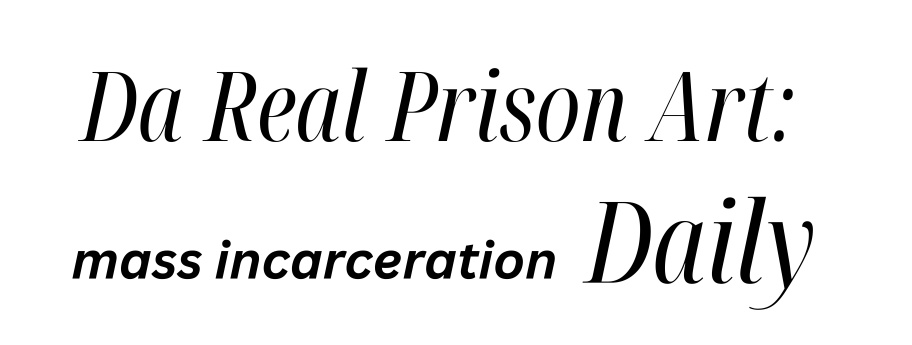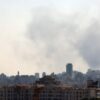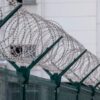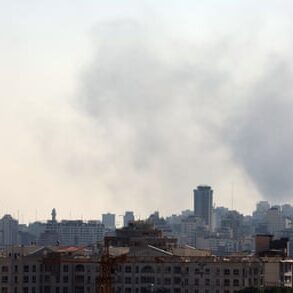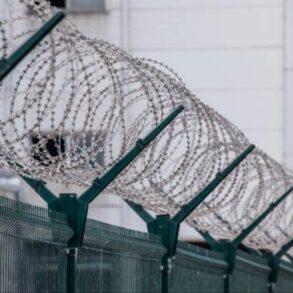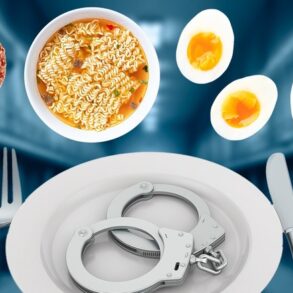Good morning. Of all the horrific symbols of the deposed Assad regime, few carry the notoriety of Sednaya, the most feared node in the Syrian government’s repressive prison system. About 30,000 people were killed there between 2011 and 2020, the Syrian Observatory for Human Rights estimated, more than in any other single location; for years, groups of 50 at a time were hanged in secret, once or twice a week.
Many were still locked up there a couple of days ago, including women and children, in conditions so disorienting and dehumanising that some were unable to say their names. But early on Sunday, as the rebels swept into Damascus, the doors were opened, and they were freed.
The first western journalist to gain access to Sednaya was the Guardian’s William Christou. His report on conditions there, and the search for those who may still be locked up, is a staggering document of the cruelty of the Assad regime that has for so long been kept out of sight. For today’s newsletter, he talks about what he saw, and the terrible uncertainty facing those whose missing loved ones have not yet been found. Here are the headlines.
Five big stories
-
Syria | Bombing raids have hit sites across Syria as regional actors in the Middle East scrambled to defend their interests in the country after the sudden fall of Bashar al-Assad. The US has struck targets associated with Islamic State (IS) in central Syria, while Turkey has attacked US-backed Kurdish forces, and Israel sent troops into the buffer zone beyond the Golan Heights.
-
US news | A 26-year-old man has been charged with murder over the shooting death of the UnitedHealthcare CEO, Brian Thompson, in New York. Luigi Mangione was arrested at a McDonald’s in Pennsylvania after a customer recognised him.
-
Media | Rupert Murdoch’s adult children will retain equal control over their father’s media empire upon his death, a Nevada court has ruled. Murdoch had wanted to wrest away power from James, Elisabeth and Prudence and give it all to his oldest son Lachlan.
-
Courts in crisis | Ministers should consider abandoning jury trials for some crown court cases unless they properly fund a justice system “in serious crisis”, the former lord chief justice has said. Lord Thomas said there had been a “political failure” by successive governments to invest in justice.
-
Culture | Jacques Audiard’s daring crime musical Emilia Pérez has dominated the Golden Globe nominations, taking 10. Conclave, the papal thriller directed by Edward Berger, got six, including for its script, direction and leading actor Ralph Fiennes, while daring body horror The Substance and Cannes Palme d’Or winner Anora both took five.
In depth: ‘It looked like it was designed to make you feel like you didn’t exist’
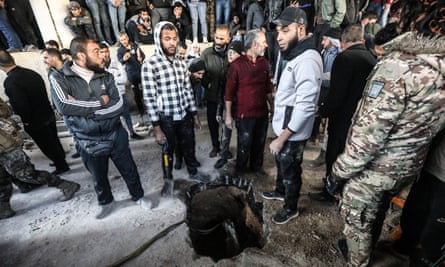
“Damascus seems like it’s coming back to life now,” Will told me, in one of a series of voice notes yesterday afternoon. “On Sunday, things were tense, people were staying home, there was a curfew – but right now I’m stuck in traffic. HTS [Hayat Tahrir al-Sham] fighters are distributed at public institutions and there are checkpoints – there’s a greater sense of security in the city.” He broke off a moment later: there was what sounded like an airstrike in the distance. Then he went on: “Otherwise, it’s scenes of joy.”
But the euphoria among Syrians in the last few days is in proportion to the horrors visited upon them by the Assad regime – and nowhere encapsulated those horrors more acutely than Sednaya.
What was known about Sednaya
The prison stands about 20km north of Damascus, high up in the hills. According to a 2022 report by the Association of Detainees and the Missing of Sednaya Prison (ADMSP), it was surrounded by anti-tank and anti-personnel mines. About 50 guards patrolled the perimeter, with separate units tasked with monitoring communications and disciplining detainees.
Neither video nor still footage has ever been published from Sednaya before the last couple of days, but a 2016 report by Amnesty International and the research group Forensic Architecture sought to reconstruct the interior of the site on the basis of survivors’ memories – a challenging task given detainees were held in darkness and under brutally enforced conditions of silence, with beatings intensifying at any sound from the victim. “In the prison, there is complete silence, the absence of all sound,” one detainee said. “It is a kind of silence you cannot conceive.”
The report describes three wings emanating from a central circulation hub, where guards could survey the locked areas but no detainee was allowed to walk without a blindfold. “In Sednaya, the architecture of the prison emerges as not only a location of torture, but itself as an instrument in its perpetration,” the report concludes.
The audio investigator who led the project, Lawrence Abu Hamdan, noted that the silence made the torture throughout the building a shared experience: “One person being tortured is like everyone being tortured, because the sound circulates throughout the space, through air vents and water pipes. You cannot escape it.”
Accounts of the torture and killing that took place at Sednaya represent an industrialised process of dehumanisation – as Amnesty International put it, a “human slaughterhouse”. Those executed were condemned to death in trials lasting a few minutes, but informed they were being transferred to a civilian prison before being taken to a basement in the dead of night and savagely beaten for hours. They were blindfolded throughout, and told of their sentence a few minutes before their death. Their remains were preserved in “salt rooms”, then transported to a hospital, recorded as having died of heart or respiratory failure, and buried in mass graves.
What happened when prisoners were freed
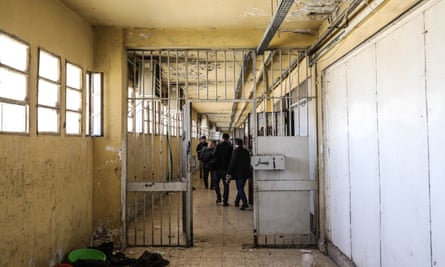



When the rebels reached Sednaya, they shot the lock off the gates, then forced doors open inside. Men poured out of cells, cheering, and helped to open more doors, while at a women’s block a toddler was filmed wandering around after the doors were opened.
As Bethan McKernan relates here, those released included Raghad al-Tatary, a pilot who refused to bomb the city of Hama during the uprising against Hafez al-Assad in the 1980s, and had been held for 43 years. Another, Tal al-Mallouhi, was 19 when she was arrested in 2009 for a blogpost criticising state corruption. Videos showed dozens of women and children held in cells, and families being reunited with loved ones who they thought could be dead. One video from the women’s block shows detainees scarcely able to believe they are free: “Bashar al-Assad is gone, he fell. Why are you afraid?” one rebel asks. “That son of a bitch fell, he is gone.”
“There was a mosque on the way to the prison, where people were stopping who had been released earlier that day,” Will said. “Some of them had lost their memories, because the torture and conditions they endured there had been so bad.”
Visiting the site
“I didn’t know exactly what to expect,” Will said. “But it looked medieval. There were cages, and I saw a prosthetic leg lying on the floor, tiny cramped cells, holes knocked into the walls where prisoners had been crammed, and dirty blankets.”
He went into the prison among a tide of people who had ditched their cars in traffic at the roadside and walked in procession to the site. His visit echoed the findings of the Forensic Architecture report: “It was really a surreal place to be in. It looked like it was designed to make you feel like you didn’t exist: all the walls were painted white, everything looked the same.”
In his piece, he writes:
The prison was seemingly built to induce a sense of placeless-ness. At its centre is a spiral staircase that from the ground floor appears endless. The staircase is ringed by metal bars and, beyond them, large identical vault doors, through which lie the facility’s three wings. According to the rebel fighters, each wing specialised in a different form of torture. There are no windows to the outside world.
When he came to leave, Will said, “we tried to get out for an hour. We got stuck going in circles, because everything looked the same. So I can only imagine, if you’re there for decades, that your grip on reality must be gone.”
Claims of an underground ‘red wing’
Stories have swirled in Syria and on social media of the “red wing”: a hidden underground complex housing untold numbers of additional prisoners feared to be choking to death because of a lack of ventilation. The Syrian Civil Defense force, the White Helmets, said that it had deployed five “specialised emergency teams” along with guides who knew the layout. There were, meanwhile, appeals from the authorities for anyone who worked for the regime and knew codes to electronically locked doors to come forward.
Wildly different numbers have circulated for the numbers supposedly locked up underground. According to the BBC, the Damascus Countryside Governorate referred to a scarcely believable 100,000; Will heard rumours of 1,500. But on Monday, the ADMSP said that its team inside the prison had concluded that there was “no truth to the presence of detainees trapped underground”, and the White Helmets said that it could find “no evidence of undiscovered secret cells or basements”.
“The issue is that the Assad regime just … left,” Will said. “They didn’t tell anyone who was in the prisons, or where they were, and all the people who knew are gone. So the rebels have to figure it out by themselves.”
after newsletter promotion
In any case, he added, “it’s likely there are other prisons we don’t know about still.” Yesterday, the White Helmets offered a $3,000 reward for information leading to secret prisons were detainees are still being held. At Sednaya, ledgers of prisoners were taken by families searching frantically for their missing loved ones, and there are concerns over whether adequate records have been preserved – or were ever kept in the first place.
Whether an underground “red wing” ever existed, it surely stands as a symbol of the terrible uncertainty facing those whose loved ones are still missing, and may very well be dead. Will spoke to 18-year-old Tamen al-Alaay as he looked for his uncle, who disappeared in 2017. “We arrived today and we searched and we searched, but we didn’t find anything,” he said. “Those in the ‘red wing’ have still not been found.”
What else we’ve been reading
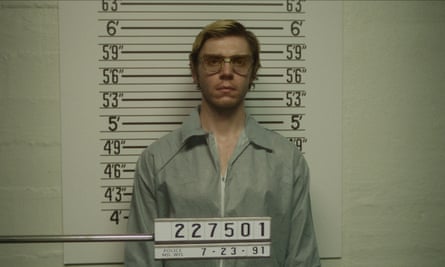



-
For this week’s Guide newsletter, Olivia Lee takes a look at what keeps drawing her back to true crime as a genre. Nimo
-
I defy you not to enjoy this How We Made about Can We Fix It?, the Bob the Builder single that was the Christmas No 1 in 2000. It features Neil Morrissey pretending to be Bob while sitting next to Ronan Keating on a flight to Australia, and composer Paul K Joyce ruminating on the arrangement: “My TV theme … was a lot more Oasis.” Archie
-
The embattled Democratic mayor of New York City, Eric Adams, who is already embroiled in legal issues, is facing further scrutiny because of his ever-closer relationship with Donald Trump. Edward Helmore has all the confounding details. Nimo
-
Andy Beckett has an acute piece about Keir Starmer’s problem with seeing off the rising far right: “Centrists are meant to be against extremism … yet centrism is also about compromise with forces that centrists believe can’t be beaten.” In the current climate, he argues, a focus on “delivery” is a doomed evasion of reality. Archie
-
The Gambia has a significant issue with plastic pollution – in 2021, the small country generated nearly 23,000 tonnes of plastic waste. That might soon change. Caitlin Kelly’s dispatch from Bijilo explores a bold national plan to try to curb plastic waste by 86%. Nimo
Sport




Football | Tomas Soucek (above) and Jarrod Bowen secured a 2-1 win for West Ham against Wolves on an evening marked by tributes to Michail Antonio after his car crash.
Football | The Premier League referee David Coote has been sacked after videos emerged of him making foul-mouthed comments about Jürgen Klopp and Liverpool, and allegedly showed him sniffing what appeared to be white powder.
Rugby union | Ronan O’Gara has declared his interest in taking a top international coaching role in the foreseeable future but will not be a contender for the Wales job should it fall vacant. The ambitious La Rochelle coach said he would be open to Ireland, England or France if the opportunity arose.
The front pages
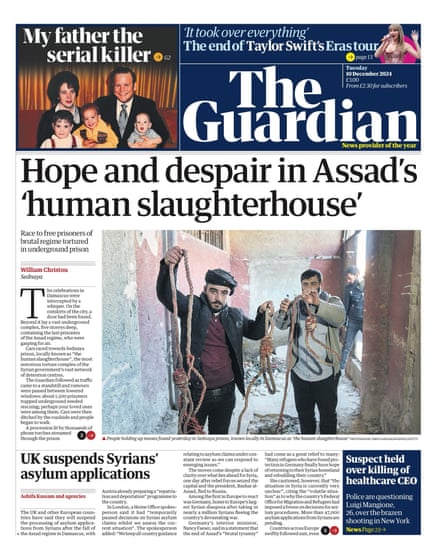



“Hope and despite in Assad’s ‘human slaughterhouse’” says the Guardian, while the Financial Times has “Syria rebels rush to consolidate power as fears of regional instability mount”. The Times says “Search for captives who escaped Assad’s noose” and the Daily Mirror picks up foreign secretary David Lammy’s description of Assad: “The rat of Damascus”. “Asylum cases on hold amid terror fear” – that’s the Daily Telegraph, with a similar perspective in the Daily Mail: “Syria chaos is a ‘chronic threat to our security’”. The i’s got that angle too: “UK to freeze decisions on Syrian asylum claims after fall of regime”. “Seriously ill children will pay the price” is the headline for the Express’s splash about national insurance. The Metro’s lead is a court case: “Stabbed to death for a teddy bear”. And the Sun leads on the sacking of a Premier League referee: “Red card for Coote”.
Today in Focus
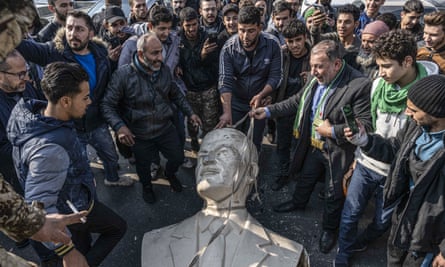



Inside Damascus after the fall of Bashar al-Assad
Foreign correspondent William Christou travels to Damascus, hours after Syria’s decades-long dictator Bashar al-Assad is ousted from power, and asks whether the country’s 13-year civil war can finally come to an end
Cartoon of the day | Rebecca Hendin




The Upside
A bit of good news to remind you that the world’s not all bad




For the last 14 years, Bally Bhamra has committed herself to truly adventurous solo travel. Since retiring at 60, she has explored southern Africa, Madagascar and south-east Asia. She prefers to stay with locals rather than in hotels, meeting hosts through Sikh temples and women’s travel networks. She has had all kinds of experiences: staying in an illegal settlement in Namibia without running water or toilets; travelling in a narrow wooden boat in Mozambique; and washing in a river in Malawi. Bhamra embraces the freedom of travelling alone. “I go into villages, stay with local people, understand the way of living, and appreciate that. I’ll do their sweeping, gardening, wash their dishes. I’m not a guest. I’m more like a member of their family.”
Bored at work?
And finally, the Guardian’s puzzles are here to keep you entertained throughout the day. Until tomorrow.
This post was originally published on this site be sure to check out more of their content.
